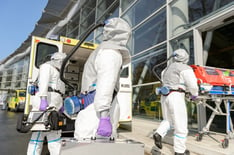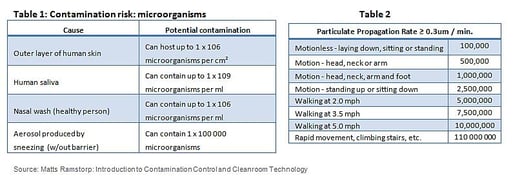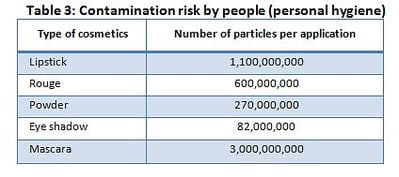It is commonly known that gowning procedures and air flow requirements are essential to maintaining a sterile clean room environment. Workers and operators don’t realize how crucial employee training is and the enormous impact employees have with the sanitation of the cleanroom. Unfortunately, humans are considered to be the biggest threat to the cleanroom and the largest source for contaminants, accounting for 75% to 80% of particles and microbes generated in a room. Understanding how personnel create particles and microbes or bring in contaminants, can help structure proper employee training, greatly bringing down the risk for clean environment contamination.
1. Human Generated
Humans can emit particles and microbes  unintentionally, naturally or through physical activity. Naturally humans can excrete microorganisms, releasing particles into the air, though sneezing, saliva, oils,hair and skin (Table 1). An adult can lose up to 6-14 grams of dead skin material every day, and a complete layer of skin every four days which is equivalent to 100,000 particles per day. The largest source for unintended particles release arises from physical activity. Most of the airborne particles migrate up personnel’s cleanroom garment collars or down their legs while walking (Table 2). In a clean room an adult will generate 100,000 particles per minute when motionless (fully gown) and will generate 1,000,000 particles per minute when walking. The more active a person becomes in the room, the more particles they compose and emit. Even the speed which they walk through the cleanroom can triple the emitted particles and also change the dynamics of the room by traveling faster than the natural air flow.
unintentionally, naturally or through physical activity. Naturally humans can excrete microorganisms, releasing particles into the air, though sneezing, saliva, oils,hair and skin (Table 1). An adult can lose up to 6-14 grams of dead skin material every day, and a complete layer of skin every four days which is equivalent to 100,000 particles per day. The largest source for unintended particles release arises from physical activity. Most of the airborne particles migrate up personnel’s cleanroom garment collars or down their legs while walking (Table 2). In a clean room an adult will generate 100,000 particles per minute when motionless (fully gown) and will generate 1,000,000 particles per minute when walking. The more active a person becomes in the room, the more particles they compose and emit. Even the speed which they walk through the cleanroom can triple the emitted particles and also change the dynamics of the room by traveling faster than the natural air flow.
2. External Environment
Personnel can accidently bring in particle contaminants through outside materials. Many personnel don’t realize cosmetics (Table 3),perfumes, colognes, deodorants, and loti ons can all invisibly excrete molecules into the air compromising the cleanroom. In addition to vanity products worn, personnel can also contaminate the room through improper cleanroom attire. Gowning protocol must be established ahead of time to avoid frequent changes out of suits, smocks or other garments,to minimize the risk for insufficient gowning and releasing clothing debris (lint, fibers, etc.).
ons can all invisibly excrete molecules into the air compromising the cleanroom. In addition to vanity products worn, personnel can also contaminate the room through improper cleanroom attire. Gowning protocol must be established ahead of time to avoid frequent changes out of suits, smocks or other garments,to minimize the risk for insufficient gowning and releasing clothing debris (lint, fibers, etc.).
Sources:
- http://www.climet.com/library/particle_sources.html- http://contaminationcontrol.dpp-europe.com/spip.php?rubrique52
- http://www.littlebrothersconstruction.com/reference/cleanroom-contamination.html
CLICK HERE to learn about other contaminants in cleanroom.


